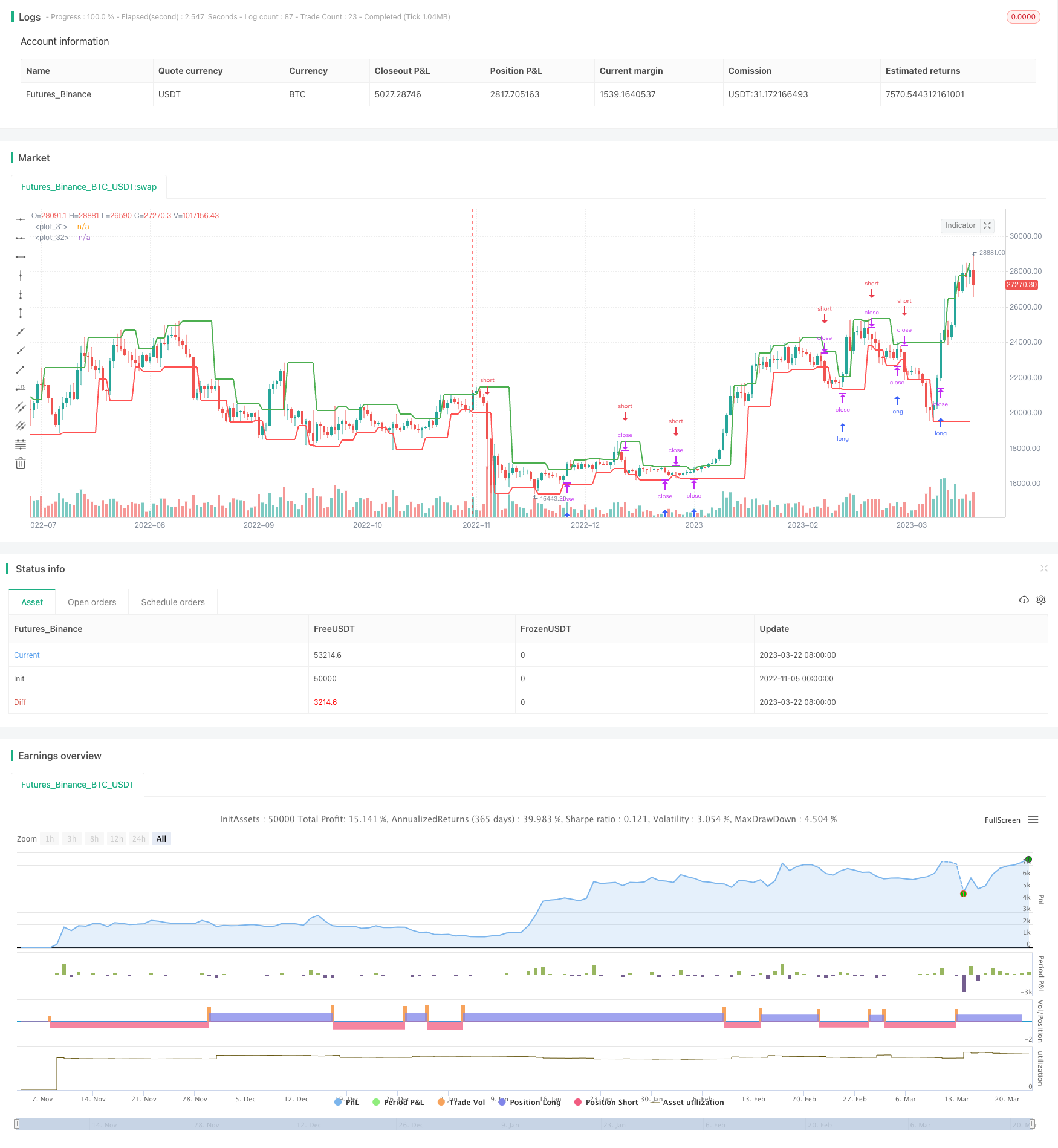
##概述 该策略利用K线的枢轴点来判断趋势反转,并以此为信号进行多空头交易。在盈利时,策略会锁定当月已实现收益,防止给回撤期带来较大亏损。
##策略原理
- 利用pivothigh()和pivotlow()函数计算K线的枢轴点。枢轴点可以判断趋势反转。
- 当价格超过上枢轴点时,做多头仓位。当价格跌破下枢轴点时,做空头仓位。
- 每月初,计算上月收益率,保存到数组。
- 每年初,计算上年收益率,保存到数组。
- 绘制收益率表格,可以直观看到每个月和年的收益情况。
##优势分析 - 利用枢轴点判断趋势反转,可以过滤掉部分噪音交易信号。 - 每月锁定收益,可以减少亏损月的影响,双极化收益。 - 收益表格直观展示每个月收益情况,可以清晰看到策略好坏时期。
##风险分析 - 枢轴点发生变化时,可能会造成错误反向开仓。可以适当优化参数或增加过滤条件。 - 月初强制平仓会错过余下月份的盈利机会。可以考虑只锁定部分头寸。 - 表格无法展示最大回撤等风险指标。可以考虑增加其他衡量策略风险的指标。
##优化方向 - 可以在枢轴点附近增加过滤条件,避免频繁无效反转交易。 - 可以只锁定部分头寸,而不是全部平仓,减少遗漏机会的可能。 - 可以增加最大回撤、夏普比率等量化风险指标在表格中的展示。
##总结 该策略利用枢轴点判断趋势反转进行交易,并在月末锁定收益,可以有效控制回撤风险。但部分参数和策略逻辑仍可进一步优化,使交易信号更准确、风险控制更稳健。表格形式的直观展示每月收益情况,也有利于策略分析。总体来说,该策略具有一定参考价值,但实盘时还需谨慎评估。
策略源码
/*backtest
start: 2022-11-05 00:00:00
end: 2023-03-23 05:20:00
period: 1d
basePeriod: 1h
exchanges: [{"eid":"Futures_Binance","currency":"BTC_USDT"}]
*/
//@version=4
strategy("Monthly Returns in PineScript Strategies", overlay = true, default_qty_type = strategy.percent_of_equity, default_qty_value = 25, calc_on_every_tick = true, commission_type = strategy.commission.percent, commission_value = 0.1)
// Inputs
leftBars = input(2)
rightBars = input(1)
prec = input(2, title = "Return Precision")
// Pivot Points
swh = pivothigh(leftBars, rightBars)
swl = pivotlow(leftBars, rightBars)
hprice = 0.0
hprice := not na(swh) ? swh : hprice[1]
lprice = 0.0
lprice := not na(swl) ? swl : lprice[1]
le = false
le := not na(swh) ? true : (le[1] and high > hprice ? false : le[1])
se = false
se := not na(swl) ? true : (se[1] and low < lprice ? false : se[1])
if (le)
strategy.entry("PivRevLE", strategy.long, comment="PivRevLE", stop=hprice + syminfo.mintick)
if (se)
strategy.entry("PivRevSE", strategy.short, comment="PivRevSE", stop=lprice - syminfo.mintick)
plot(hprice, color = color.green, linewidth = 2)
plot(lprice, color = color.red, linewidth = 2)
///////////////////
// MONTHLY TABLE //
new_month = month(time) != month(time[1])
new_year = year(time) != year(time[1])
eq = strategy.equity
bar_pnl = eq / eq[1] - 1
cur_month_pnl = 0.0
cur_year_pnl = 0.0
// Current Monthly P&L
cur_month_pnl := new_month ? 0.0 :
(1 + cur_month_pnl[1]) * (1 + bar_pnl) - 1
// Current Yearly P&L
cur_year_pnl := new_year ? 0.0 :
(1 + cur_year_pnl[1]) * (1 + bar_pnl) - 1
// Arrays to store Yearly and Monthly P&Ls
var month_pnl = array.new_float(0)
var month_time = array.new_int(0)
var year_pnl = array.new_float(0)
var year_time = array.new_int(0)
if (not na(cur_month_pnl[1]) and (new_month or barstate.islast))
array.push(month_pnl , cur_month_pnl[1])
array.push(month_time, time[1])
if (not na(cur_year_pnl[1]) and (new_year or barstate.islast))
array.push(year_pnl , cur_year_pnl[1])
array.push(year_time, time[1])
// Monthly P&L Table
var monthly_table = table(na)
if (barstate.islast)
monthly_table := table.new(position.bottom_right, columns = 14, rows = array.size(year_pnl) + 1, border_width = 1)
table.cell(monthly_table, 0, 0, "", bgcolor = #cccccc)
table.cell(monthly_table, 1, 0, "Jan", bgcolor = #cccccc)
table.cell(monthly_table, 2, 0, "Feb", bgcolor = #cccccc)
table.cell(monthly_table, 3, 0, "Mar", bgcolor = #cccccc)
table.cell(monthly_table, 4, 0, "Apr", bgcolor = #cccccc)
table.cell(monthly_table, 5, 0, "May", bgcolor = #cccccc)
table.cell(monthly_table, 6, 0, "Jun", bgcolor = #cccccc)
table.cell(monthly_table, 7, 0, "Jul", bgcolor = #cccccc)
table.cell(monthly_table, 8, 0, "Aug", bgcolor = #cccccc)
table.cell(monthly_table, 9, 0, "Sep", bgcolor = #cccccc)
table.cell(monthly_table, 10, 0, "Oct", bgcolor = #cccccc)
table.cell(monthly_table, 11, 0, "Nov", bgcolor = #cccccc)
table.cell(monthly_table, 12, 0, "Dec", bgcolor = #cccccc)
table.cell(monthly_table, 13, 0, "Year", bgcolor = #999999)
for yi = 0 to array.size(year_pnl) - 1
table.cell(monthly_table, 0, yi + 1, tostring(year(array.get(year_time, yi))), bgcolor = #cccccc)
y_color = array.get(year_pnl, yi) > 0 ? color.new(color.green, transp = 50) : color.new(color.red, transp = 50)
table.cell(monthly_table, 13, yi + 1, tostring(round(array.get(year_pnl, yi) * 100, prec)), bgcolor = y_color)
for mi = 0 to array.size(month_time) - 1
m_row = year(array.get(month_time, mi)) - year(array.get(year_time, 0)) + 1
m_col = month(array.get(month_time, mi))
m_color = array.get(month_pnl, mi) > 0 ? color.new(color.green, transp = 70) : color.new(color.red, transp = 70)
table.cell(monthly_table, m_col, m_row, tostring(round(array.get(month_pnl, mi) * 100, prec)), bgcolor = m_color)